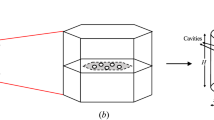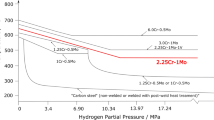Abstract
Petrochemical vessels exposed to high temperature and high pressure hydrogen gas may suffer from high temperature hydrogen attack (HTHA). HTHA is a hydrogen-induced degradation of carbon steels whereby internal hydrogen reacting with carbides forms methane gas bubbles, mainly on grain boundaries (GBs), with an associated loss in strength that can result in premature fracture of structural components. The design of equipment against HTHA is primarily based on the use of the empirical Nelson curves which are phenomenological and do not account for the underlying failure mechanisms and the material microstructure. Starting from the underlying deformation and fracture mechanisms, we present a simple constraint-based model for failure of steels by HTHA which involves growth of GB voids due to coupled diffusion of atoms along the GBs and creep of the matrix surrounding the voids. Since voids form only on some of the GBs, the uncavitated GBs geometrically constrain the growth of voids on the cavitated ones. The model is used to study void growth in HTHA of 21/4Cr–1Mo steel both in the presence and absence of externally applied stress. In the latter case, the model predictions are in good agreement with experimental results. Lastly, the model is used to develop a Nelson-curve type diagram in the presence of external stress in which the curves demarcating the safe/no-safe regimes are functions of the time to failure. This diagram though should be viewed as the result of the application of a new methodology toward devising mechanism-based Nelson curves and not as proposed new Nelson curves for the steel under investigation.












Similar content being viewed by others
Notes
See “Appendix A” for the details of Stone’s model. In order to calculate the stress on the uncavitated GBs, Stone (1984) assumed that the void growth rate approaches zero. There was a minor mistake in the calculation of Stone and the correct form for the uncavitated GB stress is \(\sigma _A \approx \left( {1/(1-f_b )} \right) \sigma _\infty +\left( {f_b /(1-f_b )} \right) p\). This equation was used to plot the void growth predictions in the figures for Stone’s model.
References
API RP 941 (2016) Steels for hydrogen service at elevated temperatures and pressures in petroleum refineries and petrochemical plants, 8th edn. American Petroleum Institute Recomended Practice 941, API Publishing Services
API TR 941 (2008) The technical basis document for API RP 941. American Petroleum Institute Technical Report 941, API Publishing Services
Chao B-L (1987) Kinetics and mechanisms of hydrogen attack in 2.25 Cr-1 Mo steel. PhD Dissertation, University of California, Santa Barbara
Chuang TJ, Kagawa KI, Rice JR, Sills LB (1979) Non-equilibrium models for diffusive cavitation of grain interfaces. Acta Metall 27:265–284. https://doi.org/10.1016/0001-6160(79)90021-X
Darken LS, Gurry RW (1953) Physical chemistry of metals. McGraw Hill, New York
Davis JR (ed) (1997) ASM specialty handbook: heat-resistant materials. ASM International, Materials Park
Erwin WE (1982) Mechanisms of hydrogen attack in 21/4Cr–1Mo reactor steel. In: 47th midyear meeting of the API. API, New York, pp 120–134
Frost HJ, Ashby MF (1982) Deformation-mechanism maps, the plasticity and creep of metals and ceramics. Pergamon Press, Oxford
Grabke HJ, Martin E (1973) Kinetics and thermodynamics of the carburization and decarburization of \(\alpha \)-iron in CH\(_4\)-H\(_2\) mixtures. Arch fuer das Eisenhuettenwes 44:837–842
Klueh RL (1980) Creep and rupture behavior of a bainitic 2 1/4 Cr–1 Mo steel. Int J Press Vessel Pip 8:165–185. https://doi.org/10.1016/0308-0161(80)90023-X
Needleman A, Rice JR (1980) Plastic creep flow effects in the diffusive cavitation of grain boundaries. Acta Metall 28:1315–1332. https://doi.org/10.1016/0001-6160(80)90001-2
Odette GR, Vagarali SS (1982) An equation-of-state for methane for modeling hydrogen attack in ferritic steels. Metall Trans A 13:299–303. https://doi.org/10.1007/BF02643320
Parthasarathy TA (1985a) Mechanisms of hydrogen attack of carbon and 21/4Cr–1Mo steels. Acta Metall 33:1673–1681
Parthasarathy TA, Lopez HF, Shewmon PG (1985b) Hydrogen attack kinetics of 2.25 Cr–1 Mo steel weld metals. Metall Trans A 16:1143–1149. https://doi.org/10.1007/BF02811683
Sagues AA, Okray Hall B, Wiederslch H (1978) On the mechanisms of hydrogen attack. Scr Metall 12:319–326
Schlogl SM, Svoboda J, Van der Giessen E (2001) Evolution of the methane pressure in a standard 2.25Cr–1Mo steel during hydrogen attack. Acta Mater 49:2227–2238. https://doi.org/10.1016/S1359-6454(01)00132-X
Schlogl SM, Van der Giessen E (2001) Micromechanics of high temperature hydrogen attack. Int J Numer Methods Eng 52:559–567. https://doi.org/10.1002/nme.299
Schlogl SM, Van der Giessen E (2002) Computational model for carbon diffusion and methane formation in a ferritic steel during hydrogen attack. Scr Mater 46:431–436. https://doi.org/10.1016/S1359-6462(02)00008-8
Schlogl SM, Van Leeuwen Y, Van der Giessen E (2000) On methane generation and decarburization in low-alloy Cr–Mo steels during hydrogen attack. Metall Mater Trans A 31:125–137. https://doi.org/10.1007/s11661-000-0059-5
Sham TL, Needleman A (1983) Effects of triaxial stressing on creep cavitation of grain boundaries. Acta Metall 31:919–926. https://doi.org/10.1016/0001-6160(83)90120-7
Shewmon PG (1976) Hydrogen attack of carbon steel. Metall Trans A 7:279–286. https://doi.org/10.1007/BF02644468
Shewmon PG (1987) Synergism between creep ductility and grain boundary bubbles. Acta Metall 35:1317–1324. https://doi.org/10.1016/0001-6160(87)90013-7
Shewmon PG, Yu ZS (1982) Hydrogen attack kinetics in 21/4Cr–1Mo pressure vessel steel. In: Degradation of materials symposium, ACS-AIME Meeting, Louisville, pp 85–92
Shih H-M, Johnson RR (1982) A model calculation of the Nelson curves for hydrogen attack. Acta Metall 30:537–545. https://doi.org/10.1016/0001-6160(82)90234-6
Stone DS (1984) Hydrogen attack in 2.25 Cr–1.0 Mo steels. PhD Dissertation, Cornell University
Sundararajan G, Shewmon PG (1981) The kinetics of hydrogen attack of steels. Metall Trans A 12:1761–1775. https://doi.org/10.1007/BF02643758
Vagarali SS, Odette GR (1981) A model for the growth of hydrogen attack cavities in carbon steels. Metall Trans A 12:2071–2082. https://doi.org/10.1007/BF02644177
Van der Burg MWD, Van der Giessen E (1996a) Non-uniform hydrogen attack cavitation and the role of interaction with creep. Mater Sci Eng A 220:200–214. https://doi.org/10.1016/S0921-5093(96)10465-2
Van der Burg MWD, Van der Giessen E (1996b) Hydrogen attach in creeping polycrystals due to cavitation on grain boundaries. In: Thompson AW, Moody NR (eds) Hydrogen effects in materials. TMS, Pittsburgh, pp 313–322
Van der Burg MWD, Van der Giessen E (1997) A continuum damage relation for hydrogen attack cavitation. Acta Mater 45:3047–3057. https://doi.org/10.1016/S1359-6454(96)00382-5
Van der Burg MWD, Van der Giessen E, Brouwer RC (1996) Investigation of hydrogen attack in 2.25 Cr–1Mo steels with a high-triaxiality void growth model. Acta Mater 44:505–518
Van der Giessen E, Van der Burg MWD, Needleman A, Tvergaard V (1995) Void growth due to creep and grain boundary at high triaxialities. J Mech Phys Solids 43:123–165
Yu ZS, Shewmon PG (1981) Hydrogen attack of 21/4 Cr–1 Mo Pressure vessel steel. In: Environmental degradation of engineering materials in hydrogen, Blacksburg, pp 253–260
Acknowledgements
The authors would like to acknowledge the funding and technical support from BP through the BP International Centre for Advanced Materials (BP-ICAM) which made this research possible.
Author information
Authors and Affiliations
Corresponding author
Additional information
Publisher's Note
Springer Nature remains neutral with regard to jurisdictional claims in published maps and institutional affiliations.
D. E. Moore: Retired from BP Jan, 2017.
Appendices
Appendix A: Stone’s model (Stone 1984)
Stone proposed a constrained void growth model for bubble growth under applied stress (Stone 1984). He considered that when void growth becomes constrained the driving force that grows the void approaches zero. Neglecting elasticity and the effect of creep, Stone calculated the void growth after it becomes constrained as
where
\(a_S^0 \) is the radius at which the constraint sets in, t is time, \(\lambda \) is the fraction of the grain that accommodates the void growth, L the grain size, \(\sigma _\infty \) the macroscopically applied stress, p the internal void pressure, \(\rho \) the bubble number density on cavitated GBs, E the Young’s modulus of elasticity, and \({\dot{\varepsilon }}_A ^{\mathrm {c}}\) the creep rate in uncavitated grain boundaries. There was a minor mistake in the calculation of the uncavitated GB stress \(\sigma _A \) and the correct form is
This equation was used to plot the void growth results shown in Figs. 4, 5, and 7 for Stone’s model. Stone considered in Eq. (5) that \(\lambda =f_b \) for the fraction of the grain which though seems to be rather small as we elaborate next in “Appendix B”.
Effect of cavitated GB area fraction \(f_b \) on the present model’s predictions of constrained void growth for a quenched and tempered 21/4Cr–1Mo steel and b normalized and tempered 21/4Cr–1Mo steel in 13.8 MPa \(\hbox {H}_{{2}}\) gas, \(600\,^{\circ }\hbox {C}\) environment, and 110 MPa external stress \(\sigma _\infty \). The grain size is L, the bubble number density on cavitated GBs \(\rho \), and the fraction of the grain that accommodates the void growth \(\lambda \) are showed on the figures. The initial void diameter was assumed \(2a_0 =0.02b = 0.0447\, \upmu \hbox {m}\) with 2b being the bubble spacing, and the calculated bubble pressure was \(p = 94.3\) MPa. The experimental data identified with error bars are also superposed for comparison (Stone 1984)
Appendix B: Effect of parameters \(\lambda \) and \(f_b \) on void growth
In order to investigate the effect of the fraction of the grain that accommodates the void growth, \(\lambda \), and the area fraction of the cavitated grains, \(f_b \), on the constrained void growth results, we simulated void growth for Q&T and N&T 21/4Cr–1Mo steels with a hydrogen gas pressure of 13.8 MPa, temperature \(600\,^{\circ }\hbox {C}\), and \(\sigma _\infty = 110\) MPa for various values of \(\lambda \) and \(f_b \). As mentioned in “Appendix A”, Stone (1984) assumed \(\lambda =f_b \) in his model. Figure 12a, b show the effect of this assumption on the void growth results respectively for Q&T and N&T 21/4Cr–1Mo steels. Superposed on the figure are the void diameter results for \(\lambda =1/3\) (Figs. 4a, 5a). Although the predictions of the present model and Stone’s model with \(\lambda =f_b \) are closer to the experimental data, we believe that the assumption \(\lambda =f_b \) is not accurate and hence it should not be adopted.
We also investigated the effect of the area fraction of the cavitated grains \(f_b \) on void growth under external load. As shown in Fig. 13, increasing \(f_b \) increases the void growth rate for both Q&T and N&T 21/4Cr–1Mo steel. However, the effect of an increasing \(f_b \) on N&T steel, Fig. 13b, is more pronounced as it also affects the initial stage of the constrained void growth process as well as the growth rate. This is attributed to the smaller value of the bubble number density on cavitated GBs \(\rho \) in the N&T steel in comparison to that in the Q&T steel which results in a larger bubble spacing 2b.
Rights and permissions
About this article
Cite this article
Dadfarnia, M., Martin, M.L., Moore, D.E. et al. A model for high temperature hydrogen attack in carbon steels under constrained void growth. Int J Fract 219, 1–17 (2019). https://doi.org/10.1007/s10704-019-00376-8
Received:
Accepted:
Published:
Issue Date:
DOI: https://doi.org/10.1007/s10704-019-00376-8





